Department of Communication offers lecture about debate viewing and social media
October 28, 2020
The WKU Department of Communication hosted a lecture Tuesday titled “The Good, The Bad and The Ugly of Social Media Use and Presidential Debate Viewing.”
It was the most recent in a lecture series called The Carl L. and Mary Ann Kell Distinguished Lecture in Communication.
The guest lecturer was Mitchell S. McKinney, a WKU alum and the director of the Political Communication Institute at the University of Missouri. McKinney spoke about the history of presidential debates, as well as the many firsts that took place in the 2020 election debate season.
“We started with the most conflictual, attack-oriented presidential debate in the history of presidential debates,” McKinney said. “We’ve documented that yet already with our content analysis of the clash that occurred, the chaos that occurred in the first presidential debate.”
He discussed some unprecedented happenings in this year’s presidential debates, like having the first woman of color female candidate for Vice President and the first debate where muting the microphones of the presidential candidates was an option.
“We then had the first presidential debate where the debate commission actually had to take the step of muting, cutting the mics of our presidential candidates and leaders because of their inability to engage in reasoned dialogue and discourse on the debate stage,” McKinney said.
McKinney also shared that his research revealed that people who were active on social media while watching presidential debates had learned more from the debate.
“We are also finding that those who tweeted more often during the debate learn more,” McKinney said. “They scored more highly on the post-debate knowledge items that we insert in a survey that then is sent to the debate watchers immediately after the debate.”
He touched on polarization and shared that viewers of debates are more polarized after watching the debate.
“Do debates make us more polarized?” McKinney asked the audience. “We have found in study after study, yes, after watching a debate, viewers become more polarized in their feelings toward the two candidates, more positive toward their in-group candidate and more negative toward their outward candidate.”
Having a curated feed and seeing one-sided messages while watching the debate can also change a person’s viewing experience and feelings afterwards. McKinney’s team did an experiment where they sorted groups of viewers based on their party identification.
McKinney explained that they conducted two experiments. They had different groups watching the debate: one of just Republicans, one of just Democrats and one of a mixed group.
“The Republicans and Democrats both received the one-sided message we pulled in real-time, during the actual debate,” McKinney said. “One of our takeaways from this study is then how do we engage because even our partisan media today, where we know which networks to go to, where we know in terms of our social media feeds, have to surround ourselves with those views that confirm our beliefs?”
The guest lecture wrapped up by relating polarization to the upcoming election and then taking questions from the audience.
“We’re seeing some of the most highly polarized effects,” McKinney said. “Particularly that first presidential debate is driven by the candidates’ dialogue. And so I admit, readily, this is not I think good for our democracy and our electoral process.”
Debra Murray can be reached at debra.murray940@topper.wku.edu. Follow her on Twitter @debramurrayy.













